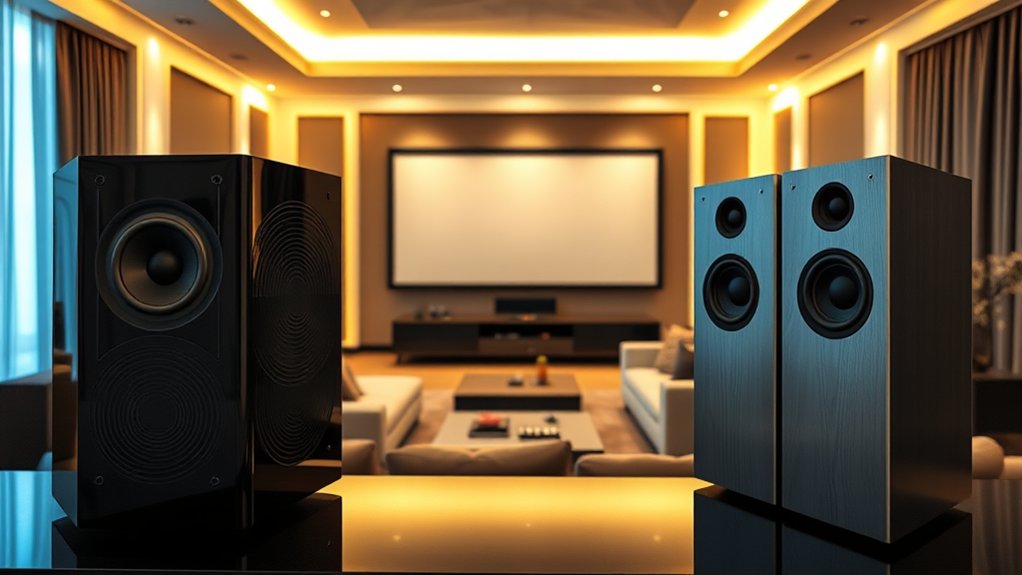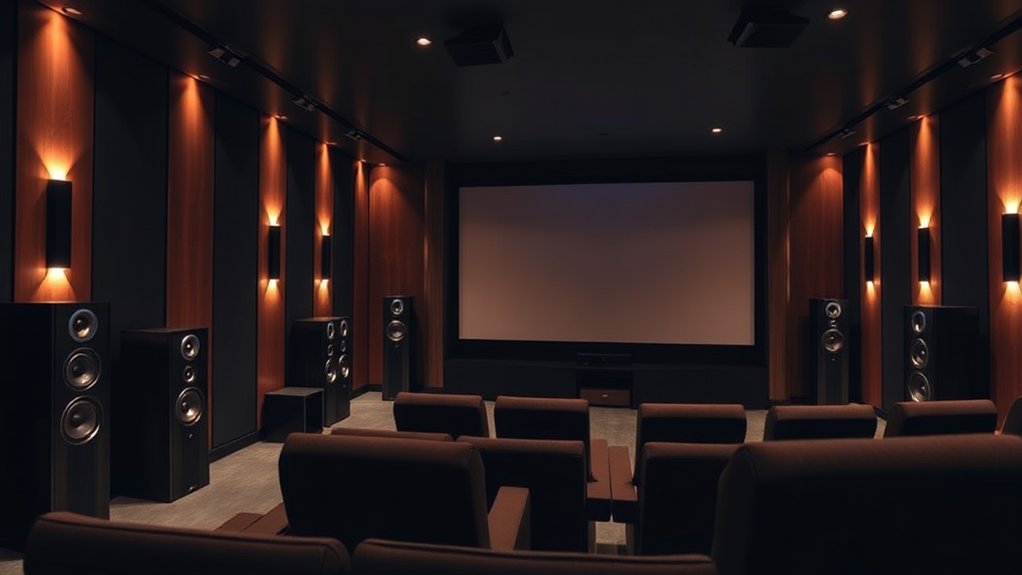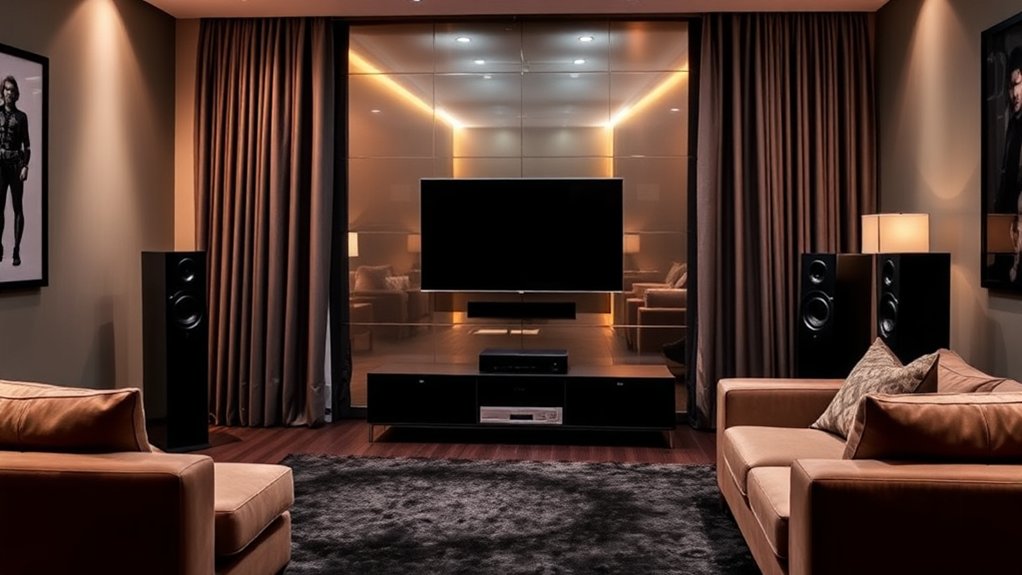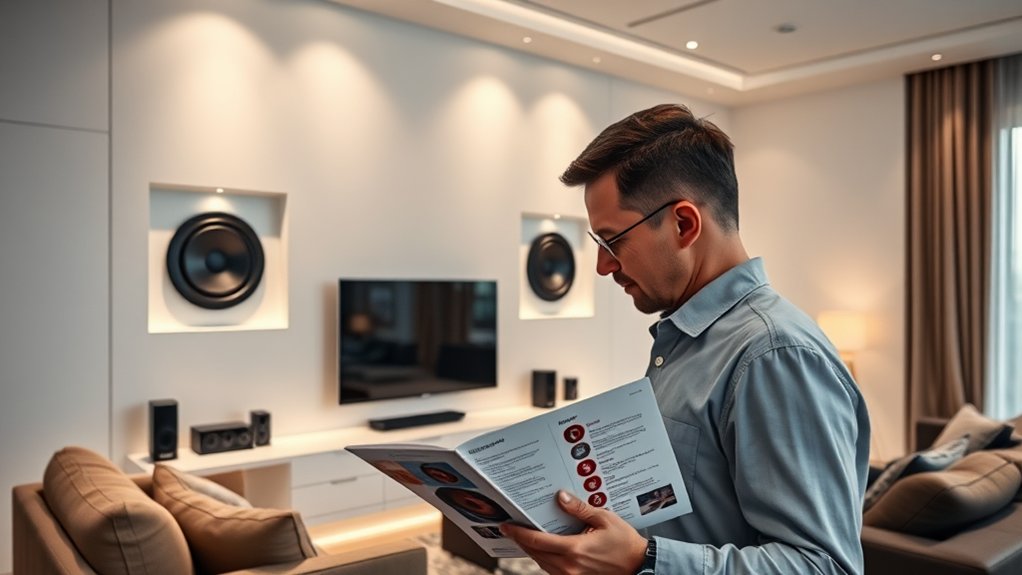Choosing energy-efficient home theater speakers is a smart move for both your wallet and the environment. These speakers deliver impressive sound quality during consuming less power, thanks to advanced designs like Class D amplifiers that achieve over 90% efficiency. Plus, features like Auto Standby cut energy use when you’re not listening. It’s like having superior sound without the guilt of high energy bills! Want to uncover more about the benefits and features of these speakers?
Key Highlights
- Energy-efficient speakers significantly reduce power consumption, leading to lower electricity bills and long-term cost savings.
- They utilize recycled materials, minimize waste, and contribute to environmental sustainability by reducing carbon footprints.
- High-sensitivity designs deliver superior sound quality with less power, ensuring impressive audio experiences even at low volumes.
- Modern features like Bluetooth connectivity and Auto Standby enhance user convenience while minimizing energy waste.
- Investing in durable, future-ready speakers allows for easy upgrades and sustained performance over time, making them a smart choice for home theaters.
Energy Efficiency and Cost Savings
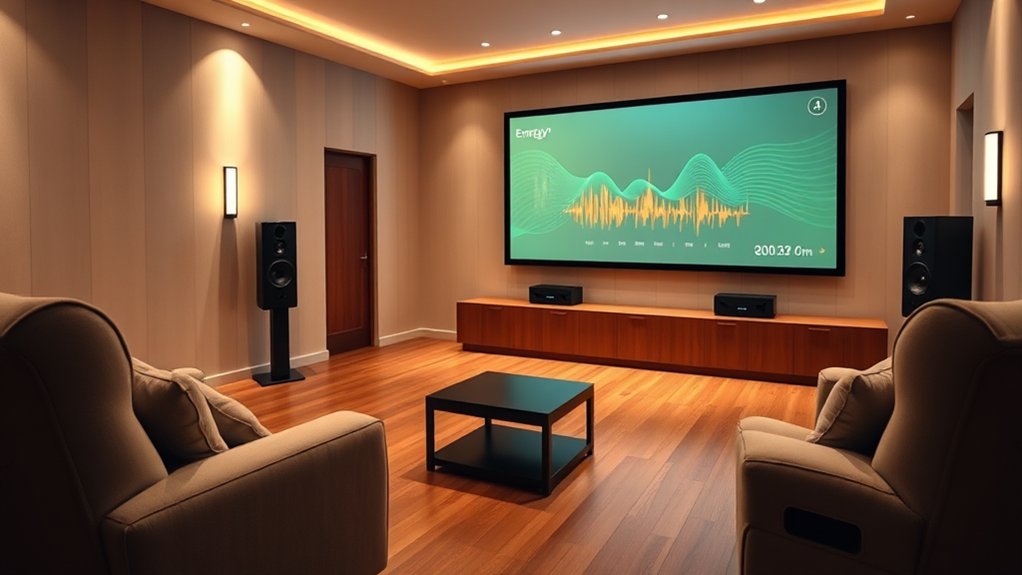
When you think about upgrading your home theater, energy efficiency and cost savings should definitely be on your radar—after all, who doesn’t want to enjoy great sound without breaking the bank?
Energy-efficient speakers not only consume less power during operation, but they additionally lower your monthly utility bills. For example, Class D amplifiers achieve efficiency rates over 90%, minimizing wasted energy. Features like Auto Standby reduce power draw when you’re not using your system. This is crucial because higher sound quality typically requires precise components, leading to increased power consumption. By selecting Energy Star labeled models, you can further enhance energy savings while enjoying superior audio quality. Moreover, integrating these speakers into your setup can ensure compatibility with advanced audio technologies, enhancing your overall experience.
Ultimately, using Energy Star certified components guarantees you’re adhering to strict standards during your enjoyment of crispy sound. Combine reduced power consumption with clever volume adjustments, and you’ll keep your audio experience intact whilst saving money.
Who knew saving energy could sound this good?
Environmental Impact
Upgrading your home theater isn’t just about enhancing your sound experience; it’s furthermore a choice that can greatly impact the environment.
By selecting energy-efficient speakers, you’re supporting brands that use up to 90% recycled materials in their products, cutting down on resource extraction and waste. Many manufacturers even repurpose electronic waste, like e-bike batteries, creating a circular economy. Additionally, the use of energy-efficient designs in these speakers often means fewer components, which not only simplifies design but likewise facilitates collaboration among speakers that can lead to superior audio output, reducing transportation emissions. Think about it: less weight equals less fuel needed for shipping!
And with their lower power consumption, you’ll likewise be reducing your carbon footprint. So, who knew enjoying your favorite films could likewise help save the planet? Every little choice counts!
Quality and Performance
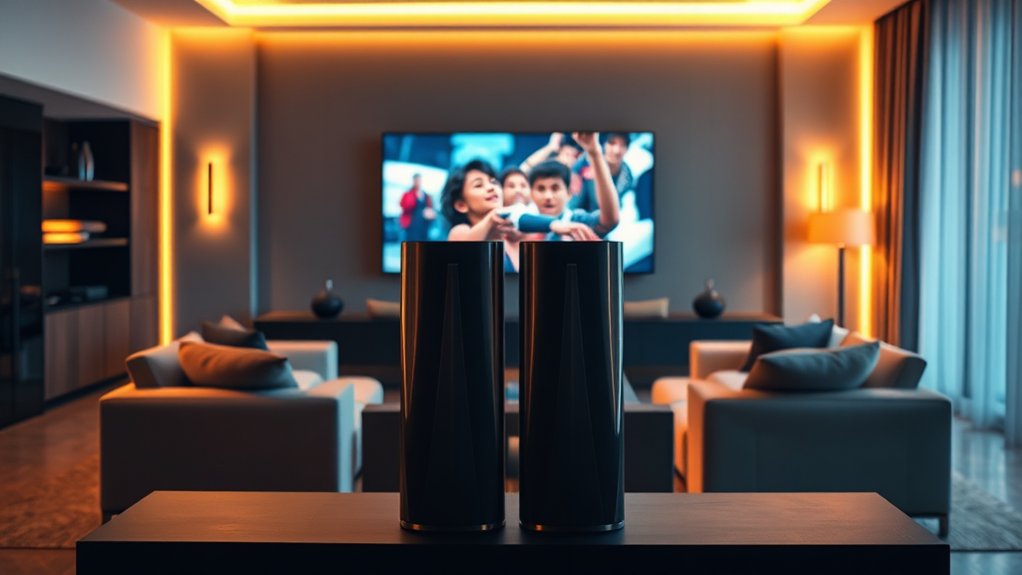
Quality and performance in energy-efficient home theater speakers can really transform your movie nights into an immersive experience that rivals the cinema, especially when you consider that these speakers often deliver particularly higher sound output than traditional models.
With sensitivity ratings between 95-100 dB, you’ll enjoy louder, clearer sound with less power, letting your lower-powered amplifiers shine without breaking the bank. Plus, horn-loaded designs maintain clarity, bringing vocals and instruments to life, all the while minimizing distortion. Additionally, typical loudspeaker efficiency highlights the substantial advantages of choosing these efficient models for your setup. Notably, the Dolby Atmos technology found in many energy-efficient systems can further enhance the immersive audio experience.
You’ll appreciate how efficient impedance keeps your amplifier from straining, prolonging its lifespan. And don’t worry—superb bass response isn’t sacrificed, even in compact spaces.
Range of Available Energy-Efficient Products
You might be surprised at just how many energy-efficient home theater speaker options are now available to fit various needs and preferences.
From Class D amplifier systems, which excel at reducing heat and maximizing efficiency, to satellite speakers with tiny yet powerful 4″ woven glass fiber woofers, there’s something for everyone.
You’ll likewise find advanced subwoofers like Yamaha’s, featuring servo technology for booming bass without excessive energy use.
Compact bookshelf and surround sound speakers don’t skimp on sound quality either, given their low power requirements.
Even within high-end models, brands like Marantz deploy dynamic amplifiers to fine-tune energy consumption alongside sound fidelity. Additionally, many soundbars like the Sonos Beam offer compact designs that maximize space while delivering excellent audio performance.
User Convenience and Modern Features
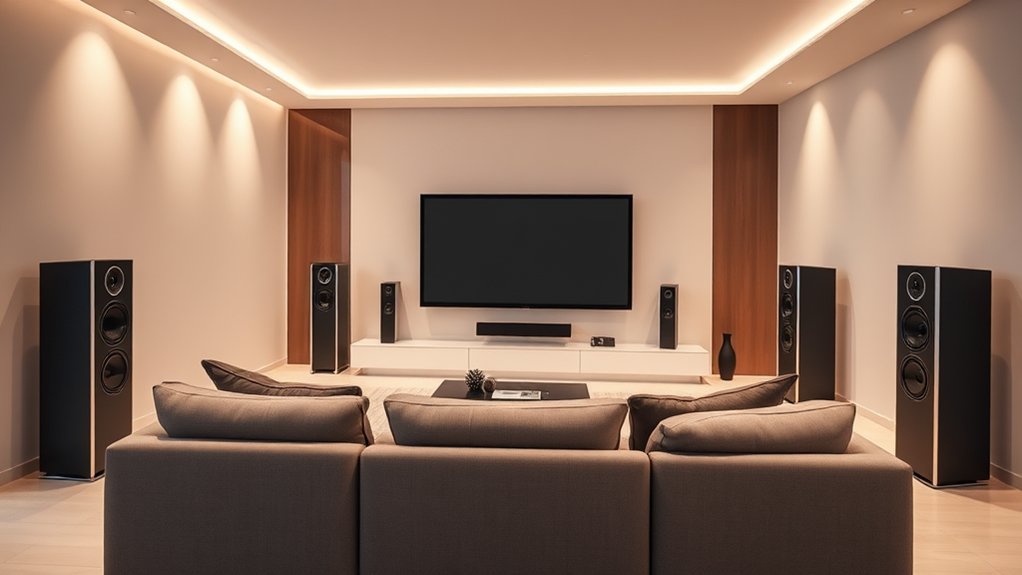
As you examine the impressive range of energy-efficient home theater speaker options, it’s clear that these advancements similarly come packed with modern features designed for user convenience.
Imagine speakers that automatically adjust for peak sound, thanks to advanced DSP technology and proprietary systems. With ECO modes and Auto Standby functionalities, you don’t have to worry about energy waste—your system takes care of itself.
Imagine speakers that optimize sound with advanced technology, ensuring energy efficiency and convenience at your fingertips.
Plus, lightweight materials make setup a breeze, so you can focus on enjoying the show instead of wrestling with cables. And with Bluetooth connectivity, controlling your audio via your smartphone feels effortless. Additionally, many models incorporate high-quality audio reproduction to ensure a captivating listening experience.
Who doesn’t appreciate features that improve your experience and make life a bit easier? It’s all about blending performance with simplicity.
Long-Term Value and Market Trends
Long-term value in energy-efficient home theater speakers isn’t just a buzzword; it’s a reality that’s drawing both consumers and manufacturers into the thriving audio environment.
As the global loudspeaker market is projected to grow greatly, you’ll find that energy-efficient designs not only save you money on electricity bills but likewise improve the longevity of the speakers.
Think about it: with technologies like Class-D amplifiers achieving over 90% efficiency, you’re investing in durability.
Major brands are innovating to meet your demands for portability, convenience, and sound quality, all during being eco-friendly.
Plus, with increasing interest in sustainable products, owning energy-efficient speakers can boost your home’s resale value.
Isn’t investing in the future just sound logic?
How Energy-Efficient Speakers Reduce Energy Consumption
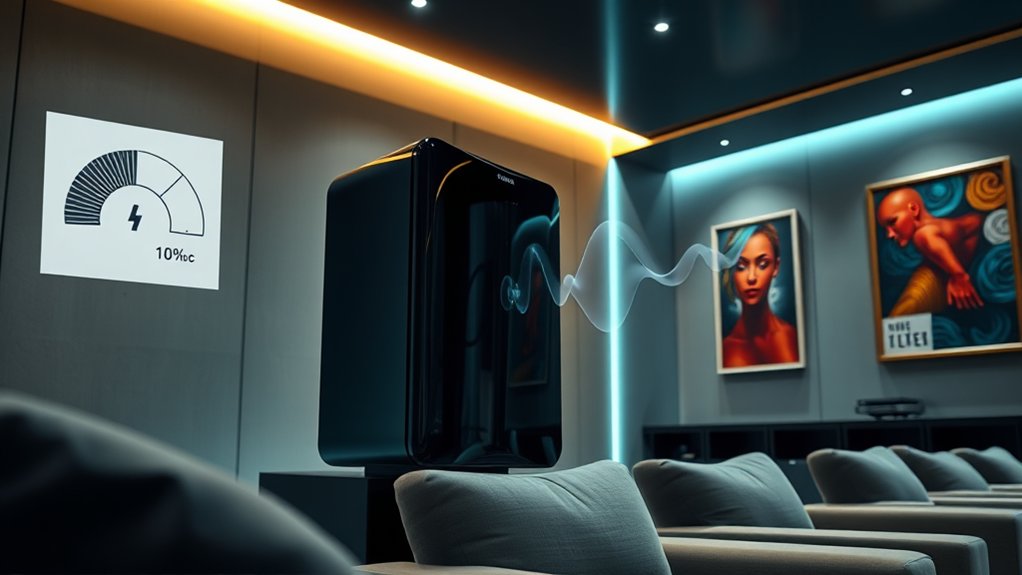
When homeowners seek to create an immersive theater experience, they often overlook a fundamental aspect: energy efficiency.
Energy-efficient speakers utilize advanced amplifier technology, like Class D amplifiers, which boast over 90% efficiency. This means they convert most electrical power into sound, with minimal wasted energy (there goes the heat!).
Improved materials make lighter speaker components that deliver more sound with less power. Smart power management features kick in when you leave the room, cutting down on energy use.
Furthermore, these speakers minimize standby power, meaning they won’t secretly drain your electricity while you’re binge-watching.
In the end, choosing energy-efficient speakers not only improves your audio experience but enhances your audio experience and saves money and reduces your carbon footprint—talk about a win-win!
Benefits of ENERGY STAR Certification
Choosing energy-efficient speakers not only improves your audio experience but furthermore opens the door to the many perks of ENERGY STAR certification. This certification means your speakers meet tough energy efficiency criteria set by the EPA, ensuring they’ve undergone rigorous testing and third-party verification.
You’ll likely notice certified speakers consume 10-20% less energy than standard models, leading to lower electricity bills—who doesn’t love that? Plus, with features like auto power down, your speakers won’t waste energy sitting idle.
And don’t worry; you won’t sacrifice sound quality for efficiency. Choosing ENERGY STAR certified speakers isn’t just smart for your wallet; it’s a choice for the environment too, helping reduce greenhouse gas emissions. How’s that for a win-win?
Comparing Energy-Efficient Speakers to Conventional Models
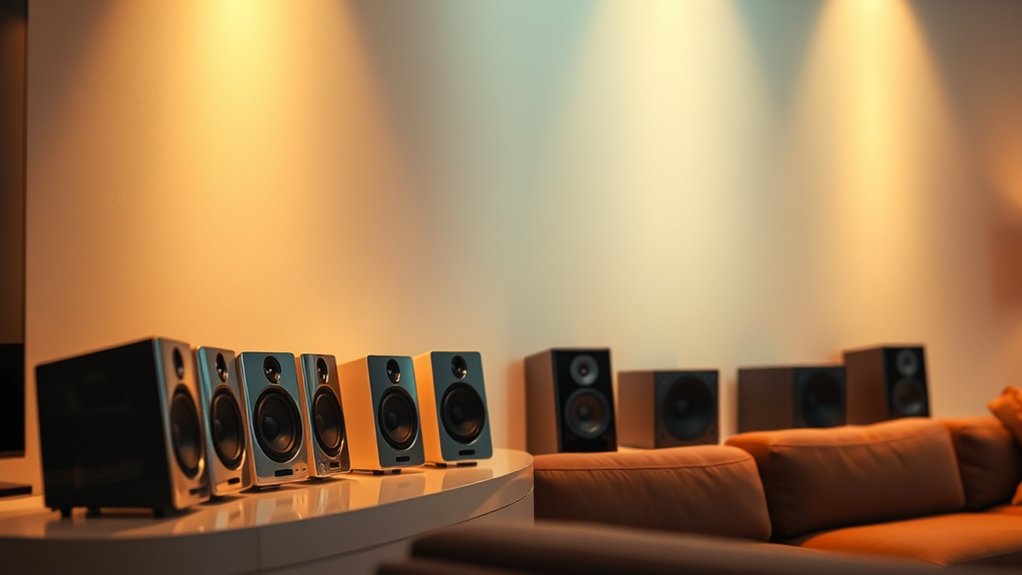
Energy-efficient speakers often utilize integrated Class D amplifiers, consuming less power without sacrificing sound quality. Think about it: a high-sensitivity energy-efficient speaker can deliver impressive volume with less amplification power—requiring under 50 watts—compared to a conventional model needing hundreds of watts.
Plus, less power means less heat, reducing cooling costs and extending your components’ lifespan. Whereas some audiophiles may favor high-end passive systems for their nuanced sound, they often pay the price in complexity and excess energy use. Notably, sound quality in compact designs has improved significantly, making energy-efficient options even more appealing for modern home theater setups.
Future-Proofing Your Home Theater System
As technology evolves at a rapid pace, future-proofing your home theater system becomes a crucial consideration for enjoying consistent, high-quality audio without the hassle of constant upgrades. By investing in high-quality, durable speakers, you guarantee longevity, as premium materials maintain sound quality over time—who wants to replace their system every few years, right? Plus, look for equipment that supports firmware upgrades; this way, you can improve performance without replacing hardware. Modular designs are another benefit, allowing you to upgrade components easily as your needs change. Finally, prioritize future-ready connectivity—ports like HDMI 2.1 and adaptive wireless tech keep your system relevant as audio tech advances. All these elements create a more sustainable, versatile home theater for years to come. Additionally, consider speakers that support Dolby Atmos technology for a more immersive audio experience as you future-proof your system.
Frequently Asked Questions
How Do I Choose the Right Energy-Efficient Speakers for My Space?
To choose the right energy-efficient speakers for your space, assess your room size and acoustics, consider speaker types, evaluate connectivity options, and look for ENERGY STAR certification to maximize performance as well as minimizing energy consumption.
Are Energy-Efficient Home Theater Speakers More Expensive Initially?
Yes, energy-efficient home theater speakers typically cost more upfront because of advanced technology and design. Nevertheless, their long-term energy savings and potential longevity can make them a worthwhile investment over time.
Can I Easily Connect Energy-Efficient Speakers to Older Equipment?
Yes, you can easily connect energy-efficient speakers to older equipment. Just use adapters or an AV receiver to bridge connections. Ensuring impedance compatibility will help maintain sound quality and avoid damaging your speakers.
Do Energy-Efficient Speakers Require Special Installation Procedures?
Energy-efficient speakers don’t need special installation procedures. Just verify correct polarity connections, use quality wires, and place them properly for peak sound. Following standard practices helps you maintain sound quality as well as minimizing power usage.
What Warranties Typically Cover Energy-Efficient Home Theater Speakers?
Typical warranties for energy-efficient home theater speakers cover 1 to 5 years, protecting against mechanical and electrical failures. You’ll need to register your purchase, and cosmetic damage or misuse usually isn’t included.

